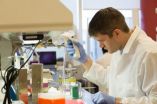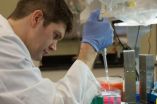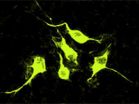(Press-News.org) HOUSTON, Feb. 27, 2014 – A University of Houston (UH) scientist and his team are working to develop the next generation of prostate cancer therapies, which are targeted at metabolism.
With approximately one out of six American men being diagnosed and nearly a quarter of a million new cases expected this year, prostate cancer is the most common malignancy among men in the U.S. Since prostate cancer relies on androgens for growth and survival, androgen ablation therapies are the standard of care for late-stage disease. While patients initially respond favorably to this course of treatment, most experience a relapse within two years, at which time limited treatment options exist. At this stage, known as castration-resistant prostate cancer, androgen-deprivation therapies are no longer effective, but interestingly, androgen receptor signaling is still active and plays a large role in the progression of the cancer. Because of this, both androgen receptors and the processes downstream of the receptor remain viable targets for therapeutic intervention. Unfortunately, it is unclear which specific downstream processes actually drive the disease and, therefore, what should be targeted.
Daniel Frigo, an assistant professor with the UH Center for Nuclear Receptors and Cell Signaling (CNRCS), has set his sights on a particular cascade of biochemical reactions inside the cell. Focusing specifically on an enzyme known as AMPK, which is considered a master regulator of metabolism, Frigo and his team have demonstrated that androgens have the capacity to take control of this enzyme's molecular signals.
"The androgen signaling cascade is important for understanding early and late-stage prostate cancer progression," Frigo said. "We found that when androgens activated this signaling pathway, it hijacked normal conditions, allowing the tumor to use diverse nutrients to the detriment of the patient. These results emphasize the potential utility of developing metabolic-targeted therapies directed toward this signaling cascade for the treatment of prostate cancer, and we look forward to exploring this and other metabolic pathways further in order to develop the next generation of cancer therapies."
In their studies, Frigo's team showed that prostate cancer cells respond to androgens not only by increasing the breakdown of sugars, a process known as glycolysis that is commonly seen in many cancers, but also escalating the metabolism of fats. While much of the research on cancer metabolism has historically focused on glycolysis, the researchers say it's now becoming apparent that not all cancers depend solely on sugars.
Their findings further indicate that the metabolic changes brought about by the AMPK enzyme result in distinct growth advantages to prostate cancer cells. They say, however, that our understanding of how androgen receptor signaling impacts cellular metabolism and what role this has in disease progression remains incomplete.
The Frigo lab is one of several within the CNRCS concentrated on the role of nuclear receptors in cancer prevention and treatment, and his team has long studied the androgen receptor, which turns on or off various signaling pathways. Frigo believes these pathways hold the potential for better cancer treatments. Targeting these underexplored metabolic pathways for the development of novel therapeutics, Frigo's ultimate goal is to unlock more effective and less harmful cancer treatment alternatives.
With funding from the Department of Defense, National Institutes of Health, Texas Emerging Technology Fund and Golfers Against Cancer, Frigo's latest research appears in Nature's Oncogene. One of the world's leading cancer journals, Oncogene covers all aspects of the structure and function of genes that have the potential to cause cancer and are often mutated or expressed at high levels in tumor cells.
INFORMATION:
About the University of Houston
The University of Houston is a Carnegie-designated Tier One public research university recognized by The Princeton Review as one of the nation's best colleges for undergraduate education. UH serves the globally competitive Houston and Gulf Coast Region by providing world-class faculty, experiential learning and strategic industry partnerships. Located in the nation's fourth-largest city, UH serves more than 39,500 students in the most ethnically and culturally diverse region in the country. For more information about UH, visit the university's newsroom at http://www.uh.edu/news-events/.
About the UH Center for Nuclear Receptors and Cell Signaling
Established in 2009, UH's Center for Nuclear Receptors and Cell Signaling (CNRCS) is a leading component of the UH Health initiative. Led by Jan-Åke Gustafsson, a National Academy of Sciences member and world-renowned expert in the field of nuclear receptors, CNRCS researchers are involved in many aspects of nuclear receptor research, all focused on understanding the roles of these receptors in health and disease. CNRCS researchers are working toward the goal of finding new treatments for an array of significant diseases including cancer, diabetes, metabolic syndrome and neurological disorders. Working from the center's world-class labs, the researchers combine interdisciplinary research and dynamic collaboration with the Texas Medical Center and industry partners.
About the College of Natural Sciences and Mathematics
The UH College of Natural Sciences and Mathematics, with 193 ranked faculty and nearly 6,000 students, offers bachelor's, master's and doctoral degrees in the natural sciences, computational sciences and mathematics. Faculty members in the departments of biology and biochemistry, chemistry, computer science, earth and atmospheric sciences, mathematics and physics conduct internationally recognized research in collaboration with industry, Texas Medical Center institutions, NASA and others worldwide.
To receive UH science news via email, sign up for UH-SciNews at http://www.uh.edu/news-events/mailing-lists/sciencelistserv/index.php.
For additional news alerts about UH, follow us on Facebook at http://www.facebook.com/UHNewsEvents and Twitter at http://twitter.com/UH_News.
Targeting metabolism to develop new prostate cancer treatments
UH scientists look at how enzyme functions correlate with disease progression
2014-02-27
ELSE PRESS RELEASES FROM THIS DATE:
New tool to unlock genetics of grape-growing
2014-02-27
University of Adelaide researchers have developed a new web-based tool to help unlock the complex genetics and biological processes behind grapevine development.
Published in the journal BMC Genomics, the researchers describe their online database that can be used to examine how almost 30,000 genes work together in groups and networks to produce the vine and its grapes.
"The complexity of plants is easily overlooked when we're enjoying a glass of wine," says project leader Associate Professor Christopher Ford at the University's School of Agriculture, Food and Wine. ...
American Bar Association awards lower ratings to women and minorities
2014-02-27
For more than half a century, the American Bar Association has vetted the nation's judicial nominees, certifying candidates as "well qualified," "qualified," or "not qualified" and in the process rankling conservatives and liberals alike when nominees earn less than stellar marks.
Now a new study suggests that the sometimes-controversial ratings could be tilted against minorities and women. An analysis of 1,770 district court nominations from 1960 to 2012 finds that the ABA systematically awards lower ratings to minorities and women than to white or male candidates. However, ...
Study identifies possible new target for future brain cancer drugs
2014-02-27
COLUMBUS, Ohio – A molecule in cells that shuts down the expression of genes might be a promising target for new drugs designed to treat the most frequent and lethal form of brain cancer, according to a new study by researchers at The Ohio State University Comprehensive Cancer Center – Arthur G. James Cancer Hospital and Richard J. Solove Research Institute (OSUCCC – James).
The findings, published in the journal Cancer Research, show that high levels of the enzyme PRMT5 are associated with aggressive growth of the brain cancer glioblastoma multiforme (GBM). The malignancy ...
Social workers' roles in patient care expand under affordable care act
2014-02-27
CHESTNUT HILL, Mass. (Feb. 27, 2014) — Social workers will see their roles in patient care expand as hospitals and other providers draw on a range of professionals to meet the demands of the Affordable Care Act, experts told the Boston College Graduate School of Social Work Forum "Health Care Reform: From Policy to Practice."
Former Harvard Pilgrim Health Care CEO Charles D. Baker Jr., the keynote speaker, said social workers bring an expansive view of care options and can play crucial roles, particularly under a "team-based care" approach.
"When I think of social workers, ...
Bison ready for new pastures?
2014-02-27
A new study from the USDA Animal and Plant Health Inspection Services (APHIS) and the Wildlife Conservation Society (WCS) demonstrates that it is possible to qualify bison coming from an infected herd as free of brucellosis using quarantine procedures. These bison can then be used to seed conservation herds in other landscapes without the threat of spreading the disease.
In response to Interagency Bison Management Plan (IBMP) guidelines on federal and state bison management actions, the USDA, APHIS Brucellosis Eradication: Uniform Methods and Rules protocol for the quarantine ...
10,000 years on the Bering land bridge
2014-02-27
SALT LAKE CITY, Feb. 27, 2014 – Genetic and environmental evidence indicates that after the ancestors of Native Americans left Asia, they spent 10,000 years in shrubby lowlands on a broad land bridge that once linked Siberia and Alaska. Archaeological evidence is lacking because it drowned beneath the Bering Sea when sea levels rose.
University of Utah anthropologist Dennis O'Rourke and two colleagues make that argument in the Friday, Feb. 28, issue of the journal Science. They seek to reconcile existing genetic and paleoenvironmental evidence for human habitation on ...
A bird's eye view of cellular RNAs
2014-02-27
BOSTON -- In biology, as in real estate, location matters. Working copies of active genes -- called messenger RNAs or mRNAs -- are positioned strategically throughout living tissues, and their location often helps regulate how cells and tissues grow and develop. But to analyze many mRNAs simultaneously, scientists have had to grind cells to a pulp, which left them no good way to pinpoint where those mRNAs sat within the cell.
Now a team at the Wyss Institute of Biologically Inspired Engineering at Harvard University and Harvard Medical School, in collaboration with ...
Scientists uncover trigger for most common form of intellectual disability and autism
2014-02-27
NEW YORK (February 27, 2014) -- A new study led by Weill Cornell Medical College scientists shows that the most common genetic form of mental retardation and autism occurs because of a mechanism that shuts off the gene associated with the disease. The findings, published today in Science, also show that a drug that blocks this silencing mechanism can prevent fragile X syndrome – suggesting similar therapy is possible for 20 other diseases that range from mental retardation to multisystem failure.
Fragile X syndrome occurs mostly in boys, causing intellectual disability ...
CU-led study says Bering Land Bridge a long-term refuge for early Americans
2014-02-27
A new study led by the University of Colorado Boulder bolsters the theory that the first Americans, who are believed to have come over from northeast Asia during the last ice age, may have been isolated on the Bering Land Bridge for thousands of years before spreading throughout the Americas.
The theory, now known as the "Beringia Standstill," was first proposed in 1997 by two Latin American geneticists and refined in 2007 by a team led by the University of Tartu in Estonia that sampled mitrochondrial DNA from more than 600 Native Americans. The researchers found that ...
Fossils offer new clues into Native American's 'journey' and how they survived the last Ice Age
2014-02-27
Researchers have discovered how Native Americans may have survived the last Ice Age after splitting from their Asian relatives 25,000 years ago.
Academics at Royal Holloway, University of London, and the Universities of Colorado and Utah have analysed fossils which revealed that the ancestors of Native Americans may have set up home in a region between Siberia and Alaska which contained woody plants that they could use to make fires. The discovery breaks new ground as until now no-one had any idea of where the native Americans spent the next 10,000 years before they appeared ...
LAST 30 PRESS RELEASES:
Tracing the quick synthesis of an industrially important catalyst
New software sheds light on cancer’s hidden genetic networks
UT Health San Antonio awarded $3 million in CPRIT grants to bolster cancer research and prevention efforts in South Texas
Third symposium spotlights global challenge of new contaminants in China’s fight against pollution
From straw to soil harmony: International team reveals how biochar supercharges carbon-smart farming
Myeloma: How AI is redrawing the map of cancer care
Manhattan E. Charurat, Ph.D., MHS invested as the Homer and Martha Gudelsky Distinguished Professor in Medicine at the University of Maryland School of Medicine
Insilico Medicine’s Pharma.AI Q4 Winter Launch Recap: Revolutionizing drug discovery with cutting-edge AI innovations, accelerating the path to pharmaceutical superintelligence
Nanoplastics have diet-dependent impacts on digestive system health
Brain neuron death occurs throughout life and increases with age, a natural human protein drug may halt neuron death in Alzheimer’s disease
SPIE and CLP announce the recipients of the 2025 Advanced Photonics Young Innovator Award
Lessons from the Caldor Fire’s Christmas Valley ‘Miracle’
Ant societies rose by trading individual protection for collective power
Research reveals how ancient viral DNA shapes early embryonic development
A molecular gatekeeper that controls protein synthesis
New ‘cloaking device’ concept to shield sensitive tech from magnetic fields
Researchers show impact of mountain building and climate change on alpine biodiversity
Study models the transition from Neanderthals to modern humans in Europe
University of Phoenix College of Doctoral Studies releases white paper on AI-driven skilling to reduce burnout and restore worker autonomy
AIs fail at the game of visual “telephone”
The levers for a sustainable food system
Potential changes in US homelessness by ending federal support for housing first programs
Vulnerability of large language models to prompt injection when providing medical advice
Researchers develop new system for high-energy-density, long-life, multi-electron transfer bromine-based flow batteries
Ending federal support for housing first programs could increase U.S. homelessness by 5% in one year, new JAMA study finds
New research uncovers molecular ‘safety switch’ shielding cancers from immune attack
Bacteria resisting viral infection can still sink carbon to ocean floor
Younger biological age may increase depression risk in older women during COVID-19
Bharat Innovates 2026 National Basecamp Showcases India’s Most Promising Deep-Tech Ventures
Here’s what determines whether your income level rises or falls
[Press-News.org] Targeting metabolism to develop new prostate cancer treatmentsUH scientists look at how enzyme functions correlate with disease progression









